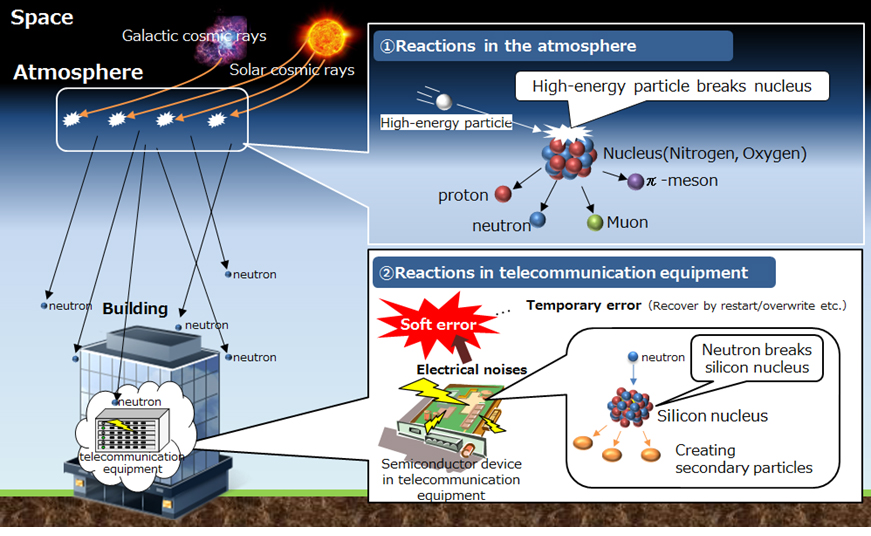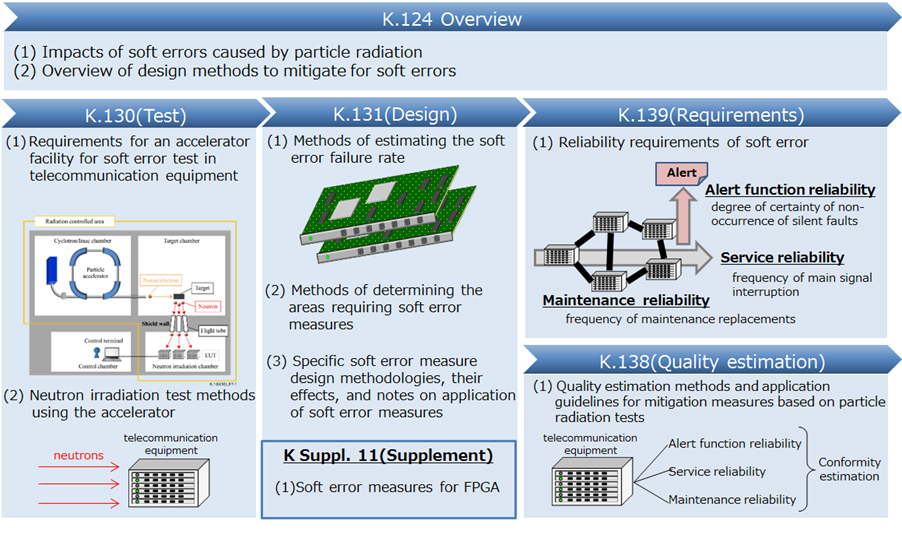Archived content
NOTE: this is an archived page and the content is likely to be out of date.
International standards adopted by ITU-T to address soft errors affecting telecommunication equipment
Enhancing reliability based on Recommendations for design, testing, and quality estimation of measures designed to mitigate soft errors caused by cosmic rays
Nippon Telegraph and Telephone Corporation,Fujitsu Limited,Hitachi, Ltd.,NEC Corporation,Oki Electric Industry Company Limited,Orange,The Telecommunication Technology Committee
Tokyo, November 22, 2018
ITU-T which is the United Nations specialized agency approved standards about soft errors(1) affecting telecommunication equipment on November 13, 2018. These standards stipulate the design, testing and quality estimation methods and reliability requirements concerning measures designed to mitigate malfunctions (soft errors) in telecommunication equipment on the ground chiefly caused by cosmic rays.
To develop these standards, NTT, Fujitsu, Hitachi, NEC, and Oki jointly developed draft Recommendations at "the Ad Hoc Committee on Soft Error Testing (SOET_Adhoc)" formed by TTC, and have driven efforts at ITU-T SG5(2) meetings, with the cooperation of Orange, to have these drafts adopted by ITU-T.
The adopted standards will help to establish networks that are more highly reliable based on the requirements governing measures against soft errors.
Background
In recent years, the number of soft errors caused by cosmic radiation neutrons has been increasing gradually even in telecommunication equipment located on the ground.(Figure 1) The soft error disappears as soon as the semiconductor device concerned is restarted or the data concerned are overwritten. Even though a soft error in data can cause a malfunction or system outage, it is difficult to reproduce such a transient error and identify the cause. Since a soft error can have a serious impact on the user, it is a major headache for system operators. Telecommunication equipment is designed so that such malfunctions do not affect network services. However, because soft errors are difficult to reproduce, they were not sufficiently verified at the development stage.
Recently, however, it has become possible to measure the influence of soft errors on telecommunication equipment using a compact accelerator-driven neutron source(3). This measurement makes it possible to determine the influence of soft errors and take preventive measures in advance before vendors sell products and telecommunication carriers introduce telecommunication equipment into operating networks. While it has become possible for carriers to improve network quality dramatically by mitigating soft errors at the stages of equipment development and introduction, there is a need for requirements that serve as the benchmark for methods and evaluation of countermeasure.
Recommendations for soft errors in ITU-T
Against this background, at the October 2015 meeting of ITU-T SG5, commencement of a study program on soft errors in telecommunication equipment was approved with the intention of defining requirements on measures against soft errors, ranging from design to evaluation and quality. The SOET_Adhoc member companies worked together and developed draft Recommendations. ITU-T has now approved these Recommendations.
The Recommendations stipulate the design, testing and quality estimation methods and reliability requirements concerning soft errors. They include benchmarks based on which vendors and carriers can select measures against soft errors that are appropriate for the required reliability level.
The soft-error-related standards approved by ITU-T consist of five Recommendations and a supplement. Figure 2 shows an overview of the Recommendations.
Each Recommendation or supplement defines the following items:
K.124 (Overview) Overview of particle radiation effects(4) on telecommunication systems
- Impacts of soft errors caused by particle radiation.
- Overview of design methods to mitigate the impacts of soft errors.
K.130 (Test) Neutron irradiation test methods for telecommunication equipment
- Requirements for the accelerator facility used to test soft errors in telecommunication equipment
- Neutron irradiation test methods that use an accelerator
K.131 (Design) Design methodologies for telecommunication systems applying soft error measures
- Methods of estimating the soft error failure rate depending on the devices used and equipment configuration.
- Methods of determining the areas requiring soft error measures.
- Specific soft error measure design methodologies, their effects, and notes on application of soft error measures.
K Suppl. 11 (Supplement) Soft error measures of field programmable gate arrays
- Soft error measure examples for field programmable gate arrays (FPGAs).
K.139 (Requirements) Reliability requirements for telecommunication systems affected by particle radiation
- Definitions of standards concerning the frequency of maintenance replacements and the frequency of main signal interruption, and the degree of certainty of non-occurrence of silent faults, due to soft errors.
K.138 (Quality estimation) Quality estimation methods and application guidelines for mitigation measures based on particle radiation tests
- Method of determining whether various reliability requirements for telecommunication equipment regarding software defined in K.139 (Requirements) are satisfied or not, based on the results of the neutron irradiation test described in K.130 (Test).
It is expected that widespread deployment of telecommunication equipment that satisfies the requirements defined in these Recommendations will improve the reliability of telecommunication services.
Attachment
Reference (27 KB/A4, 1 page)
About Fujitsu
Fujitsu is the leading Japanese information and communication technology (ICT) company, offering a full range of technology products, solutions, and services. Approximately 140,000 Fujitsu people support customers in more than 100 countries. We use our experience and the power of ICT to shape the future of society with our customers. Fujitsu Limited (TSE: 6702) reported consolidated revenues of 4.1 trillion yen (US $39 billion) for the fiscal year ended March 31, 2018. For more information, please see www.fujitsu.com.
Contact Information
Information Network Laboratory Group, Planning Department, Public Relations Section
 E-mail: inlg-pr-pb-ml@hco.ntt.co.jp
E-mail: inlg-pr-pb-ml@hco.ntt.co.jp
Company:Nippon Telegraph and Telephone Corporation
Press Contacts
Public and Investor Relations Division
Inquiries
Company:Fujitsu Limited
Contact Information
Systems & Services Business Division, Service & Platform Business Development Department, E2E MONOZUKURI Innovation Operation
 E-mail: fumihiko.nagasaki.ev@hitachi.com
E-mail: fumihiko.nagasaki.ev@hitachi.com
Company:Hitachi, Ltd.
Contact Information
Public Relations Division
 E-mail: press@oki.com
E-mail: press@oki.com
Company:Oki Electric Industry Co., Ltd.
Contact Information
Kaoru Yoshida, Director, Standardization
 E-mail: info@ttc.or.jp
E-mail: info@ttc.or.jp
Company:The Telecommunication Technology Committee
All company or product names mentioned herein are trademarks or registered trademarks of their respective owners. Information provided in this press release is accurate at time of publication and is subject to change without advance notice.
Date: 22 November, 2018
City: Tokyo
Company:
Nippon Telegraph and Telephone Corporation ,Fujitsu Limited ,Hitachi, Ltd. ,NEC Corporation ,Oki Electric Industry Co., Ltd. ,Orange ,The Telecommunication Technology Committee
![]() E-mail: inlg-pr-pb-ml@hco.ntt.co.jp
E-mail: inlg-pr-pb-ml@hco.ntt.co.jp![]() E-mail: fumihiko.nagasaki.ev@hitachi.com
E-mail: fumihiko.nagasaki.ev@hitachi.com![]() E-mail: j-jasper@ax.jp.nec.com
E-mail: j-jasper@ax.jp.nec.com![]() E-mail: press@oki.com
E-mail: press@oki.com![]() E-mail: vanessa.clarke@orange.com
E-mail: vanessa.clarke@orange.com![]() E-mail: info@ttc.or.jp
E-mail: info@ttc.or.jp
